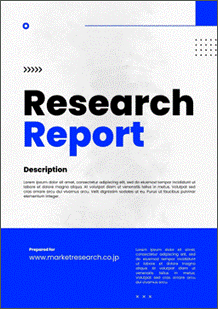 | • レポートコード:MRC2403B363 • 出版社/出版日:Transparency Market Research / 2023年12月 • レポート形態:英文、PDF、173ページ • 納品方法:受注後3営業日 • 産業分類:医療 |
| Single User | ¥857,660 (USD5,795) | ▷ お問い合わせ |
| Multi User | ¥1,301,660 (USD8,795) | ▷ お問い合わせ |
| Corporate License | ¥1,745,660 (USD11,795) | ▷ お問い合わせ |
• お支払方法:銀行振込(納品後、ご請求書送付)
レポート概要
| 甲状腺疾患治療市場 - レポートの範囲TMRの世界甲状腺疾患治療市場に関する調査レポートは、2023年から2031年までの予測期間における市場の指標に関する貴重な洞察を得るために、過去だけでなく現在の成長動向と機会を調査しています。当レポートでは、2023年を基準年、2031年を予測年として、2017年から2031年までの世界の甲状腺疾患治療市場の収益を提供しています。また、2023年から2031年までの世界の甲状腺疾患治療市場の複合年間成長率(CAGR %)も掲載しています。 本レポートは広範な調査を経て作成されました。主要オピニオンリーダー、業界リーダー、オピニオンメーカーへのインタビューを実施しました。二次調査では、甲状腺疾患治療市場を理解するために、主要企業の製品資料、年次報告書、プレスリリース、関連文書を参照しました。 二次調査には、インターネット情報源、政府機関の統計データ、ウェブサイト、業界団体なども含まれた。アナリストは、世界の甲状腺疾患治療市場の様々な属性を調査するために、トップダウンアプローチとボトムアップアプローチの組み合わせを採用しました。 本レポートには、調査範囲に含まれる様々なセグメントの成長動向のスナップショットとともに、詳細なエグゼクティブサマリーが含まれています。さらに、世界の甲状腺疾患治療市場における競争ダイナミクスの変化に光を投げかけています。これらは、既存の市場プレイヤーだけでなく、世界の甲状腺疾患治療市場への参入に関心のある企業にとっても貴重なツールとなります。 当レポートでは、世界の甲状腺疾患治療市場の競争環境について掘り下げています。世界の甲状腺疾患治療市場で事業を展開する主要企業が特定され、これらの各企業が様々な属性でプロファイリングされています。会社概要、財務状況、最近の動向、SWOTは、本レポートでプロファイリングされた世界の甲状腺疾患治療市場におけるプレイヤーの属性です。 世界の甲状腺疾患治療市場レポートで回答された主な質問 - 予測期間中の全地域における甲状腺疾患治療が生み出す売上高/収益は? - 世界の甲状腺疾患治療市場における機会は何か? - 市場における主な促進要因、阻害要因、機会、脅威は何か? - 予測期間中に最も速いCAGRで拡大する地域市場はどこか? - 2031年に世界で最も高い収益を上げると予測されるセグメントは? - 予測期間中に最も高いCAGRで拡大すると予測されるセグメントは? - 世界市場で事業を展開する各企業の市場ポジションは? 甲状腺疾患治療市場 - 調査目的と調査アプローチ 世界の甲状腺疾患治療市場に関する包括的なレポートは、概要から始まり、調査範囲と目的が続きます。本レポートでは、本調査の目的、市場で事業を展開する主要ベンダーや流通業者、製品承認のための規制シナリオについて詳細に解説しています。 本レポートは、読みやすさを考慮し、各セクションを章ごとに分割したレイアウトになっています。本レポートは、グラフや表が適切に散りばめられた網羅的なコレクションで構成されています。主要セグメントの実績値と予測値を図式化し、読者に視覚的に訴えます。また、過去と予測期間末の主要セグメントの市場シェアの比較も可能です。 当レポートでは、世界の甲状腺疾患治療市場を製品、エンドユーザー、地域の観点から分析しています。各基準の主要セグメントを詳細に調査し、2031年末時点での各セグメントごとの市場シェアを掲載しています。このような貴重な洞察は、市場関係者が世界の甲状腺疾患治療市場への投資のための情報に基づいたビジネス上の意思決定を行うことを可能にします。 |
1. エグゼクティブサマリー
2. 仮定・調査手法
3. エグゼクティブサマリー:世界の甲状腺疾患治療市場
4. 市場概要
5. 主要インサイト
6. 甲状腺疾患治療市場分析・予測:障害別
7. 世界の甲状腺疾患治療市場分析・予測:地域別
8. 北米の甲状腺疾患治療市場分析・予測
9. ヨーロッパの甲状腺疾患治療市場分析・予測
10. アジア太平洋の甲状腺疾患治療市場分析・予測
11. 中南米の甲状腺疾患治療市場分析・予測
12. 中東/アフリカの甲状腺疾患治療市場分析・予測
13. 競争状況
1. Executive Summary
1.1. Market Definition and Scope
1.2. Market Segmentation
1.3. Key Research Objectives
1.4. Research Highlights
2. Assumptions and Research Methodology
3. Executive Summary: Global Thyroid Gland Disorders Treatment Market
4. Market Overview
4.1. Market Segmentation
4.1.1. Segment Definition
4.1.2. Industry Evolution / Developments
4.2. Overview
4.3. Market Dynamics
4.3.1. Drivers
4.3.2. Restraints
4.3.3. Opportunities
4.4. Global Thyroid Gland Disorders Treatment Market Analysis and Forecast, 2023-2031
5. Key Insights
5.1. Pipeline Analysis
5.2. List of Types of Thyroid Gland Disorder Tests
5.3. Disorder Prevalence & Incidence Rate Globally With Key Countries
5.4. COVID-19 Pandemic Impact on Industry
6. Thyroid Gland Disorders Treatment Market Analysis and Forecast, by Disorder
6.1. Introduction and Definitions
6.2. Key Findings/Developments
6.3. Market Value Forecast, by Disorder, 2023-2031
6.3.1. Hypothyroidism
6.3.1.1. Levothyroxine
6.3.1.2. Liothyronine
6.3.2. Hyperthyroidism
6.3.2.1. Imidazole
6.3.2.2. Propacil
6.4. Market Attractiveness, by Disorder
7. Global Thyroid Gland Disorders Treatment Market Analysis and Forecast, by Region
7.1. Key Findings
7.2. Market Value Forecast, by Region, 2023-2031
7.2.1. North America
7.2.2. Europe
7.2.3. Asia Pacific
7.2.4. Latin America
7.2.5. Middle East & Africa
7.3. Market Attractiveness, by Region
8. North America Thyroid Gland Disorders Treatment Market Analysis and Forecast
8.1. Introduction
8.1.1. Key Findings
8.2. Market Value Forecast, by Disorder, 2023-2031
8.2.1. Hypothyroidism
8.2.1.1. Levothyroxine
8.2.1.2. Liothyronine
8.2.2. Hyperthyroidism
8.2.2.1. Imidazole
8.2.2.2. Propacil
8.3. Market Attractiveness, by Disorder
8.4. Market Value Forecast, by Country, 2023–2031
8.4.1. U.S.
8.4.2. Canada
8.5. Market Attractiveness Analysis
8.5.1. By Disorder
8.5.2. By Country
9. Europe Thyroid Gland Disorders Treatment Market Analysis and Forecast
9.1. Introduction
9.1.1. Key Findings
9.2. Market Value Forecast, by Disorder, 2023-2031
9.2.1. Hypothyroidism
9.2.1.1. Levothyroxine
9.2.1.2. Liothyronine
9.2.2. Hyperthyroidism
9.2.2.1. Imidazole
9.2.2.2. Propacil
9.3. Market Attractiveness, by Disorder
9.4. Market Value Forecast, by Country/Sub-region, 2023–2031
9.4.1. Germany
9.4.2. U.K.
9.4.3. France
9.4.4. Italy
9.4.5. Spain
9.4.6. Rest of Europe
9.5. Market Attractiveness Analysis
9.5.1. By Disorder
9.5.2. By Country/Sub-region
10. Asia Pacific Thyroid Gland Disorders Treatment Market Analysis and Forecast
10.1. Introduction
10.1.1. Key Findings
10.2. Market Value Forecast, by Disorder, 2023-2031
10.2.1. Hypothyroidism
10.2.1.1. Levothyroxine
10.2.1.2. Liothyronine
10.2.2. Hyperthyroidism
10.2.2.1. Imidazole
10.2.2.2. Propacil
10.3. Market Attractiveness, by Disorder
10.4. Market Value Forecast, by Country/Sub-region, 2023-2031
10.4.1. China
10.4.2. Japan
10.4.3. India
10.4.4. Australia & New Zealand
10.4.5. Rest of Asia Pacific
10.5. Market Attractiveness Analysis
10.5.1. By Disorder
10.5.2. By Country/Sub-region
11. Latin America Thyroid Gland Disorders Treatment Market Analysis and Forecast
11.1. Introduction
11.1.1. Key Findings
11.2. Market Value Forecast, by Disorder, 2023-2031
11.2.1. Hypothyroidism
11.2.1.1. Levothyroxine
11.2.1.2. Liothyronine
11.2.2. Hyperthyroidism
11.2.2.1. Imidazole
11.2.2.2. Propacil
11.3. Market Attractiveness, by Disorder
11.4. Market Value Forecast, by Country/Sub-region, 2023-2031
11.4.1. Brazil
11.4.2. Mexico
11.4.3. Rest of Latin America
11.5. Market Attractiveness Analysis
11.5.1. By Disorder
11.5.2. By Country/Sub-region
12. Middle East & Africa Thyroid Gland Disorders Treatment Market Analysis and Forecast
12.1. Introduction
12.1.1. Key Findings
12.2. Market Value Forecast, by Disorder, 2023-2031
12.2.1. Hypothyroidism
12.2.1.1. Levothyroxine
12.2.1.2. Liothyronine
12.2.2. Hyperthyroidism
12.2.2.1. Imidazole
12.2.2.2. Propacil
12.3. Market Attractiveness, by Disorder
12.4. Market Value Forecast, by Country/Sub-region, 2023-2031
12.4.1. GCC Countries
12.4.2. South Africa
12.4.3. Rest of Middle East & Africa
12.5. Market Attractiveness Analysis
12.5.1. By Disorder
12.5.2. By Country/Sub-region
13. Competition Landscape
13.1. Market Player – Competition Matrix (By Tier and Size of Companies)
13.2. Market Share Analysis, by Company (2022)
13.3. Company Profiles
13.3.1. Merck KGaA
13.3.1.1. Company Overview (HQ, Business Segments, Employee Strength)
13.3.1.2. Disorder Portfolio
13.3.1.3. Financial Overview
13.3.1.4. SWOT Analysis
13.3.1.5. Strategic Overview
13.3.2. Pfizer, Inc.
13.3.2.1. Company Overview (HQ, Business Segments, Employee Strength)
13.3.2.2. Disorder Portfolio
13.3.2.3. Financial Overview
13.3.2.4. SWOT Analysis
13.3.2.5. Strategic Overview
13.3.3. Takeda Pharmaceutical Company Ltd.
13.3.3.1. Company Overview (HQ, Business Segments, Employee Strength)
13.3.3.2. Disorder Portfolio
13.3.3.3. Financial Overview
13.3.3.4. SWOT Analysis
13.3.3.5. Strategic Overview
13.3.4. Allergan
13.3.4.1. Company Overview (HQ, Business Segments, Employee Strength)
13.3.4.2. Disorder Portfolio
13.3.4.3. Financial Overview
13.3.4.4. SWOT Analysis
13.3.4.5. Strategic Overview
13.3.5. Sanofi S.A.
13.3.5.1. Company Overview (HQ, Business Segments, Employee Strength)
13.3.5.2. Disorder Portfolio
13.3.5.3. Financial Overview
13.3.5.4. SWOT Analysis
13.3.5.5. Strategic Overview
13.3.6. AbbVie Inc.
13.3.6.1. Company Overview (HQ, Business Segments, Employee Strength)
13.3.6.2. Disorder Portfolio
13.3.6.3. Financial Overview
13.3.6.4. SWOT Analysis
13.3.6.5. Strategic Overview
13.3.7. Lannet Company, Inc.
13.3.7.1. Company Overview (HQ, Business Segments, Employee Strength)
13.3.7.2. Disorder Portfolio
13.3.7.3. Financial Overview
13.3.7.4. SWOT Analysis
13.3.7.5. Strategic Overview
13.3.8. Aspen
13.3.8.1. Company Overview (HQ, Business Segments, Employee Strength)
13.3.8.2. Disorder Portfolio
13.3.8.3. Financial Overview
13.3.8.4. SWOT Analysis
13.3.8.5. Strategic Overview